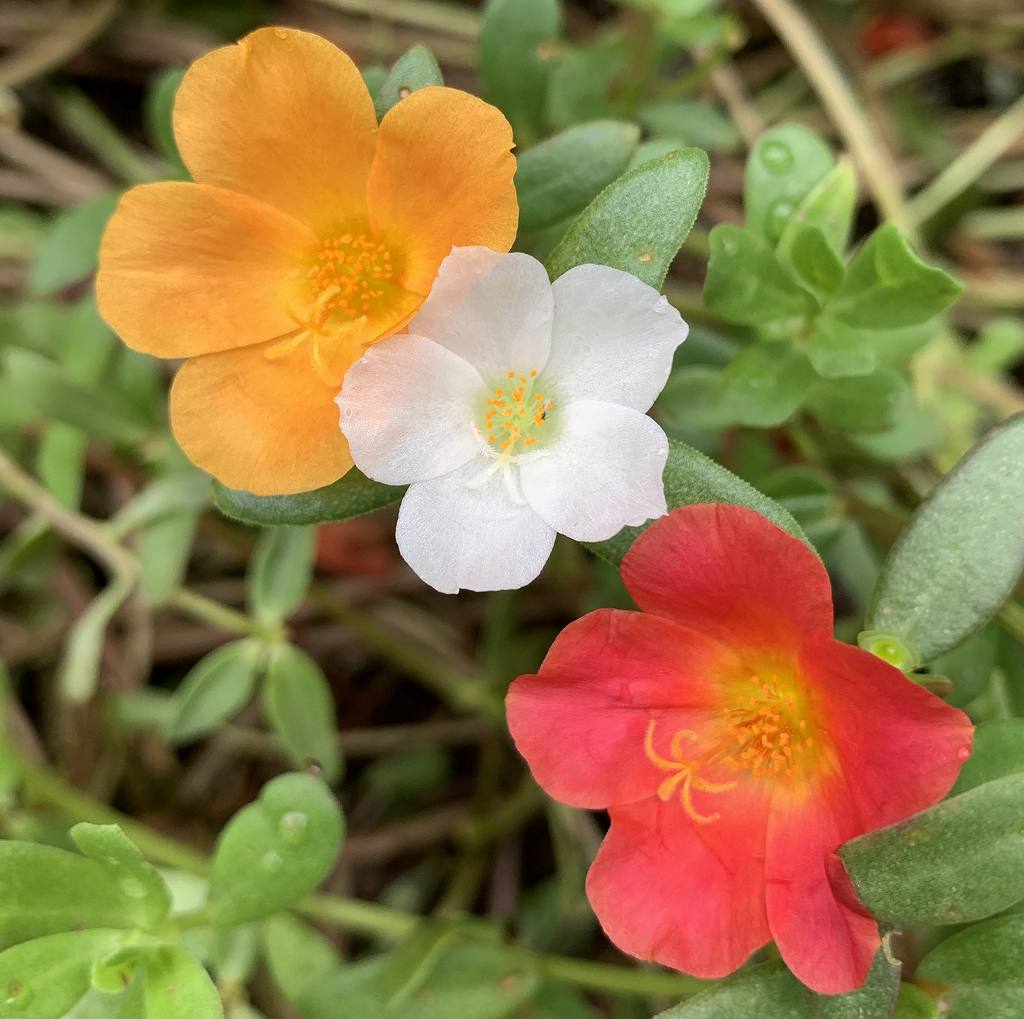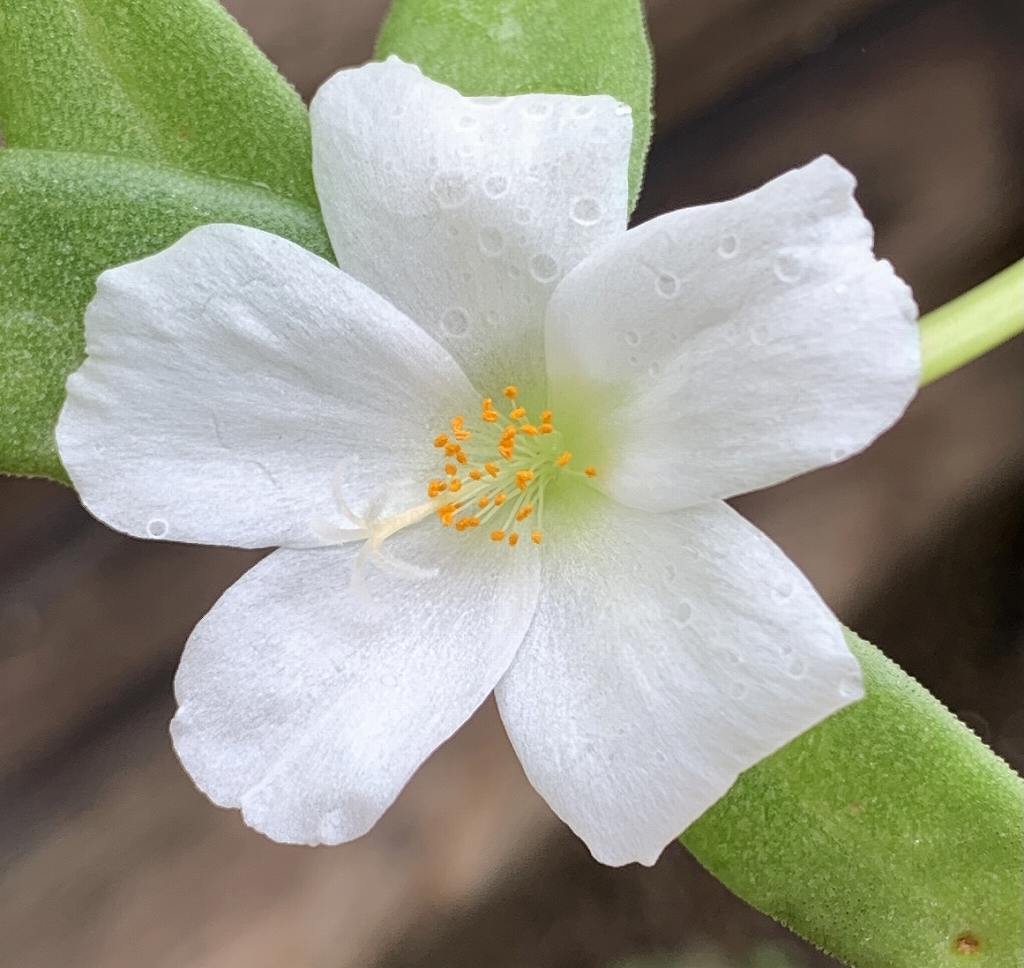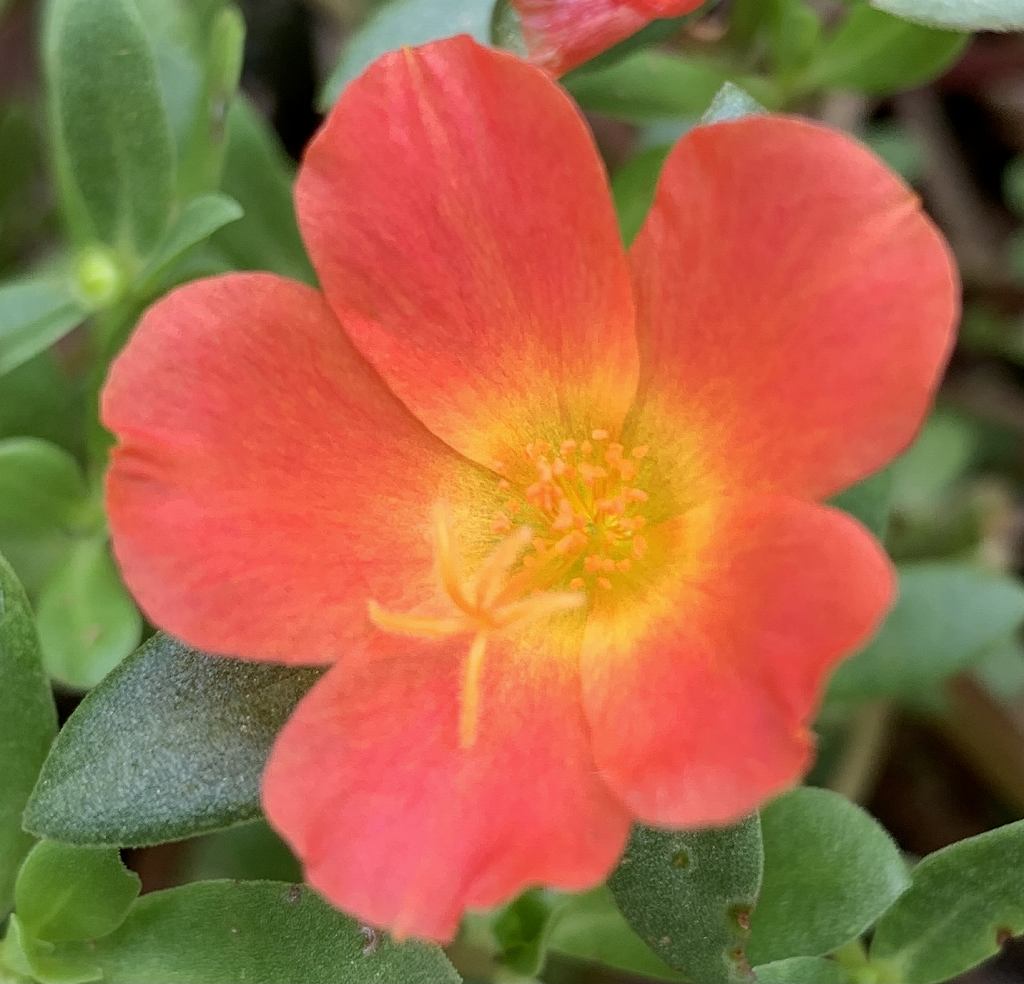ハナスベリヒユは洋名「ポーチュラカ」。夏の暑さや乾燥にも負けず、鮮やかな花を咲かせるので、花言葉は「いつも元気」「無邪気」です。
Green Purslane is the Western name “Portulaca”. The flower language is “always fine” and “innocent” because it blooms bright flowers despite the heat and dryness of summer.
【仮名】ハナスベリヒユ, ポーチュラカ
【和名】花滑寛
【英名】Green Purslane, Portulaca
【学名】Portulaca oleracea
【誕生】06/ 29, 07/ 16, 09/ 26, 09/ 29
【開花】06, 07, 08, 09, 10月
【花色】White, Pink, Red, Purple, Yellow, Orange






ハナスベリヒユ
ハナスベリヒユの名前
ハナスベリヒユはスベリヒユ属の一年草。世界の熱帯~温帯に広く分布しています。名前の「スベリ」の由来は、茎葉に滑るような光沢があるから、または茎葉を茹でると滑りが出るから。洋名の「ポーチュラカ」は属名に由来し、近縁では「マツバボタン」が同じスベリヒユ属です。
ハナスベリヒユの形態
ハナスベリヒユは赤紫色の茎が根元から分岐して地面を這い、枝分かれしながら広がります。葉はヘラ形で、柄は短く、茎葉ともに多肉質で無毛。花は大きさが2~3cm、花弁が5枚です。果実は帽子のような蓋果。中に黒く微小な種子がびっしり詰まり、熟すと弾けて飛び散ります。
ハナスベリヒユの光合成
ハナスベリヒユは普通のC3型植物にない機能を持っています。それもC4型とCAM型の両方の機能を併せ持つ植物。二酸化炭素を濃縮して利用するC4型植物は強光下でも光合成でき、二酸化炭素を夜間に蓄積して昼間に利用するCAM型植物は乾燥した環境でも光合成できます。
ハナスベリヒユの花言葉
ハナスベリヒユはC4型植物のトウモロコシのように強い日差しの下でしっかり育ち、CAM型植物のサボテンのように砂漠のようなところで萎れない植物。ハナスベリヒユは夏の暑さに負けず、鮮やかな花を咲かせるので、「いつも元気」「無邪気」という花言葉がつけられました。
ハナスベリヒユの食用
ハナスベリヒユはスベリヒユと同じように食べられます。たとえば、若い茎葉は水にさらしてアクを抜き、茹でてお浸しに。茎葉は熱を加えると、独特の滑りが出ます。ヨーロッパではハーブとしても利用され、炒めてサラダにしたり、スープにも。さらに実もパンに混ぜたりします。
ハナスベリヒユの薬用
ハナスベリヒユはスベリヒユのようにω-3脂肪酸という機能成分を多く含む植物です。スベリヒユは中国で「五行草」という生薬で、解熱、解毒、利尿や虫刺されに利用。また、遡って古代ローマのプリニウス著『博物誌』でも、さまざまな傷病に効く薬草として紹介されています。
Green Purslane
Name of Green purslane
Green purslane is an annual plant of the genus Purslane. It is widely distributed in the tropical to temperate zones of the world. The name “slip” comes from the fact that the foliage has a slippery luster, or that boiling the foliage causes slippage. The Western name “Portulaca” is derived from the genus name, and closely related to the genus Purslane, which has the same “Matsuba button”.
Form of Green purslane
The red-purple stem of Green purslane branches from the root and crawls on the ground, branching and spreading. The leaves are spatula-shaped, the stalks are short, and the stems and leaves are fleshy and hairless. The flowers are 2-3 cm in size and have 5 petals. The fruit is a cap-like fruit. Black and tiny seeds are packed tightly inside, and when ripe, they pop and scatter.
Photosynthesis of Green purslane
Green purslane has functions not found in ordinary C3 type plants. It is also a plant that has both C4 type and CAM type functions. C4 type plants that concentrate and use carbon dioxide can photosynthesize even in strong light, and CAM type plants that accumulate carbon dioxide at night and use it in the daytime can photosynthesize even in a dry environment.
Flower language of Green purslane
Green purslane is a plant that grows well in strong sunlight like the C4 type plant corn and does not wither in desert-like places like the CAM type plant cactus. Green purslane does not lose to the heat of summer and blooms bright flowers, so the flower words “always fine” and “innocent” were added.
Edible Green purslane
Green purslane can be eaten in the same way as purslane. For example, soak young foliage in water to remove lye, boil and soak. When heat is applied to the foliage, a unique slip occurs. It is also used as an herb in Europe, and can be fried to make salads or soups. In addition, the fruit is also mixed with bread.
Medicinal Green purslane
Green purslane is a plant that contains a large amount of functional components called ω-3 fatty acids, like purslane. Portulaca oleracea is a crude drug called “Gogyosou” in China, which is used for antipyretic, detoxifying, diuresis and insect bites. In addition, it has been introduced as a medicinal herb that is effective against various injuries and illnesses in “Natural History” by Pliny the Elder in ancient Rome.


